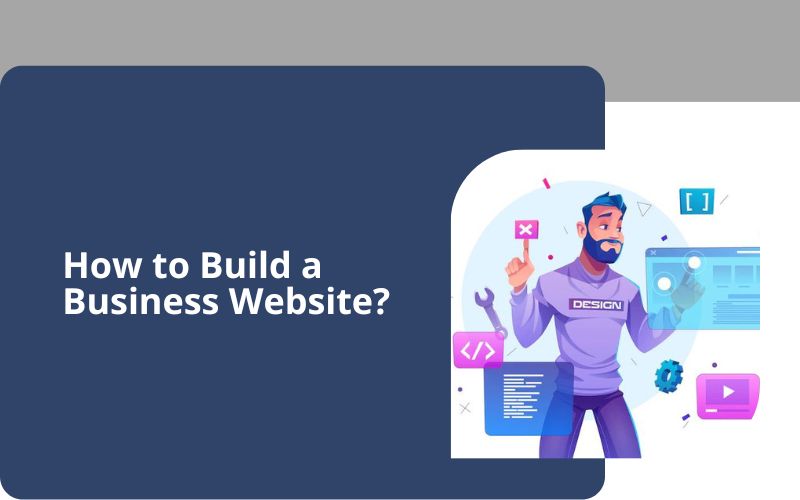A robust website is crucial for the success of your small business, regardless of whether you run a graphic design business, are a freelance photographer, or run another kind of small business. We know what it takes to build compelling and captivating business websites.
It would be best to make a few decisions before developing your website. Even though you might be eager to get started right away, planning carefully now will help you save a lot of hassle later on.
10 Amazing Tips on How to Build a Business Website
So, how exactly do you create a website? Fortunately, technological advancements have recently kept up with the enormous demand for tools that make building websites more accessible. Without prior knowledge of web design, creating your website has never been simpler.
This article gives a brief overview of the procedures for creating a website for your company and offers recommendations for tools based on the nature of your industry and level of technical expertise.
Here are ten crucial stages to getting started and assisting your small company website to effectively compete in the internet marketplace if you’re trying to develop a new startup website or make your current site more effective.
1. Find a Catchy Domain Name
The leading portal to your website is your domain name and website address. It must leave a positive first impression to be effective for both search engine optimization and usability (SEO).

Here are some suggestions for selecting the best domain name for your business:
- Make the wording simple.
- Make it as short as you can.
- Please use the correct domain extension. Always try to use the a.com domain name.
- Avert using hyphens and numerals.
- Make the address inclusive to allow for future expansion.
- Make it memorable, please.
- Verify that the price is fair.
- Avert names that make no sense.
- Make a URL that is search engine optimized.
2. Invest in Scalable Secure Website Hosting
A company that provides the technology and services required for a website to be seen on the internet is known as a website host (or, occasionally, a website hosting provider). You link your domain name to your web host so that users who access your website address are directed to the website you have stored on your hosting account.

Depending on the technology and support you want, hosting services might cost anywhere from $2 to $100+ per month. If you purchase a yearly plan instead of a monthly one, you will typically receive a discount.
3. Display a Concise Description of Your Company Prominently
To avoid confusion when customers visit your small company website, it’s critical to communicate who you are and what you do immediately.
Make sure your primary homepage banner (often known as a “hero image”), any subsequent banners, and the introductory text blurb at the top of the page all serve as visual representations of your services.
Additionally, ensure that the “About Us” page links on your principal and footer navigation menus are displayed so visitors can click them and read additional in-depth information about your company.
4. Use the Most Suitable Content Management System
A software program or application used to create and manage digital material is a content management system (CMS). Your site can be maintained with a competent CMS; using one doesn’t require any technical know-how.

You should pick a CMS tailored to your specific requirements because different platforms are employed for various factors, including user-friendliness, extensibility, and cost.
5. Pick a Reliable E-Commerce Platform
You will need the right technology if you intend to sell products and services on your website. (If you don’t sell anything already, you might want to think about starting since e-commerce could perhaps boost your income.)

You must select the right platform for your business model if you plan to allow users to conduct financial transactions with you online.
6. Design an Intriguing, Enduring, and Captivating Website User Interface
Make sure the user experience on your small company website generates results. You can achieve this by putting the following advice into practice:
Ensure the typeface and images of your website are legible and eye-catching:
- Ensure that your visuals are optimized and compressed for quick download. Search engines like Google will lower your rating if your website is slow.
- Implement comparable elements that will work for your small company website after researching the competition to see how they have designed and optimized their websites.
- Find out what your target audience wants from your website through research, and then make it simple for them to obtain it.
- Maintain brand identity throughout the entire design of your website.
- Create a user-friendly navigation system that allows people to access the required pages easily.
- Publicize contact details that are simple to find.
- Be sure to include calls to action, mainly “purchase now” buttons.
7. Make Your Company Website Search Engine Optimized
For search engines to properly index, rank, and display your website to search engine users, you must implement a set of techniques known as SEO on your website. Your website will compete with other websites that contain comparable material once search engines have “crawled” it. Your website will rank higher on search engine result pages the better it is designed and written.

The following techniques are primarily used in SEO:
- Keyword exploration and application
- Best website coding
- Page Speed
- Having an SSL certificate installed
- Having a mobile-friendly site
- Existence of high-quality backlinks to your website (links on other websites with relevant content)
- Obtaining many favourable reviews online (Google, Yelp, Facebook, etc.)
- Utilizing internal connections on your website will keep visitors clicking and reading.
- Linking to your website using social media.
SEO is an enormously crucial continuing process that can mean the difference between showing up on the first page of search engine results pages (leading to large quantities of free traffic to your website) or page 300 (resulting in no traffic) (resulting in no traffic).
8. Put Webmaster Tools in Place
Install Google Analytics, Google Search Console, Bing Webmaster Tools, and other tools to use essential data to help you monitor traffic and site performance. Preferably, it would help if you did this using Google Tag Manager. The following kinds of data can be tracked using these tools:
- Monthly, weekly, and daily site visitors.
- Views per page on your site, in numbers.
- Google algorithms give higher rankings to websites with a low bounce rate, on the theory that visitors spend more time on the site find it valuable.
- Visitors’ average time on the site.
- Mistakes in the site’s crawl.
- Site links that are broken.
- Attracting keywords for your website.
- Links pointing to your site.
- Download time for a website.
- Additional details that can improve your SEO.
9. Create and Publish Quality Content Regularly
Create a plan to publish high-quality articles and blog entries on your site and on external websites that link to your site because search engines value both the amount and the freshness of your material.
You must update your website with fresh, pertinent material as regularly as possible if you want to rank well in search engine results and draw visitors back repeatedly.

Testimonials are an excellent type of material to post on your website in addition to static page content and articles.
An excellent method to post new, high-quality content on your website that increases the appeal of your small business is to solicit customer testimonials, which you can then place on it. Assure that the tone of your content is suitable and consistent with your brand.
10. Implement a Website Maintenance Plan
A website shouldn’t be built and then left to remain outdated. You must ensure your website is properly maintained to have a successful one that performs well in search engine results and isn’t hacked.
To build a small business website maintenance strategy, consider the following advice:
- At least once each month, check Webmaster Tools data, and have any critical mistakes immediately emailed to you.
- Learn more about your audience using traffic statistics so you can better serve them.
- To improve and correct mistakes and warnings, use performance data.
- Update all software on a regular basis.
- Conduct security checks to ensure that your website is free of malware and has not been compromised.
- Use “split testing” to determine whether specific changes to your website’s design can improve its functionality. For instance, if you’re selling a product, you might have two variations of a particular landing page with different images and copy; split testing lets you determine which version has a higher conversion rate.
- Continue to publish high-quality material
- Find trendy and successful online marketing strategies for your company.
- Allow website visitors to comment on your site.
- Continue to periodically check out what your rivals are doing with their internet presence to determine if what they’ve done can also work for you.
Wrap Up!
As you can tell from reading this post, building a fantastic small company website can be more complex than you initially anticipated. However, the availability of high-quality, user-friendly technologies should make your job much more straightforward than expected.
However, your small business will have a great chance of prospering in the online market if you stick to the instructions provided in this article.





